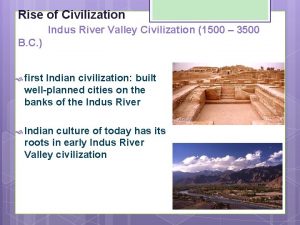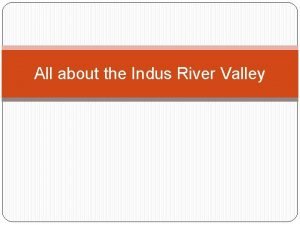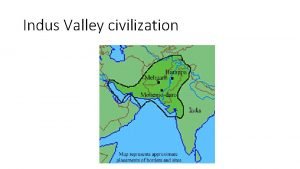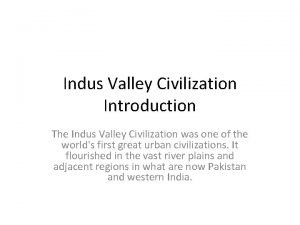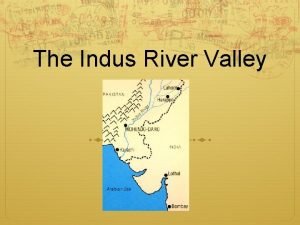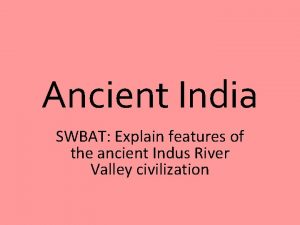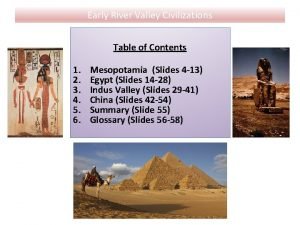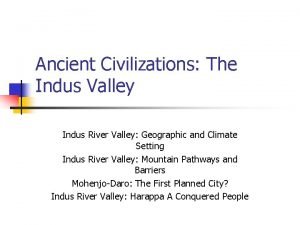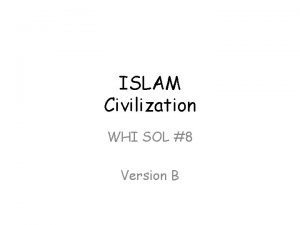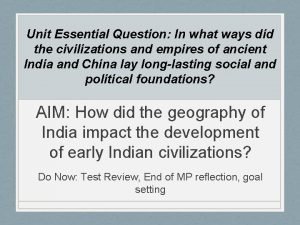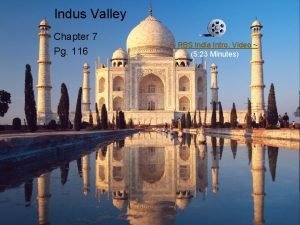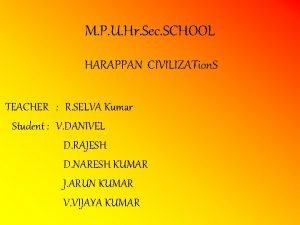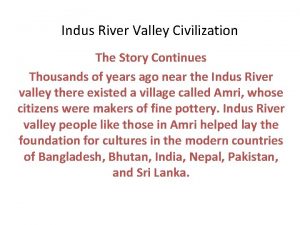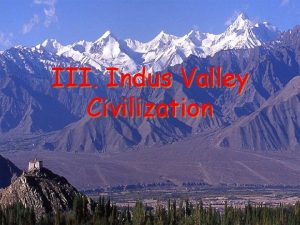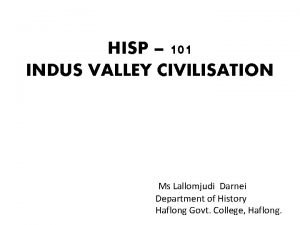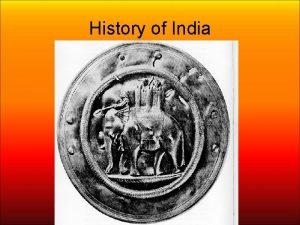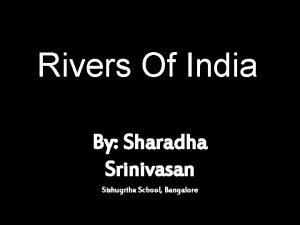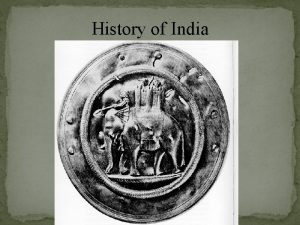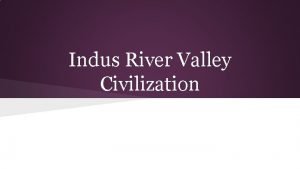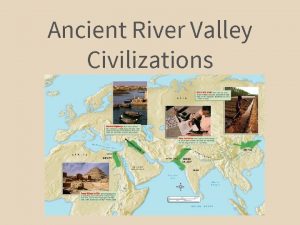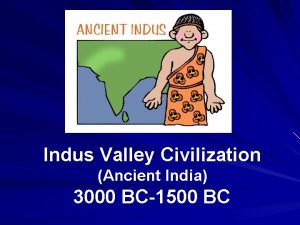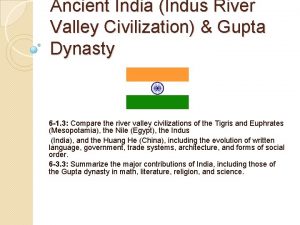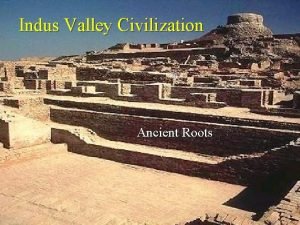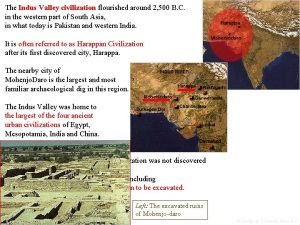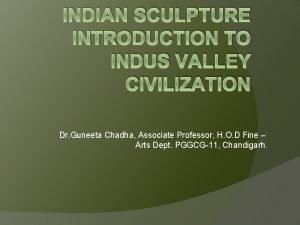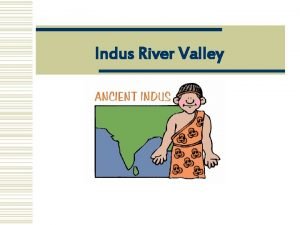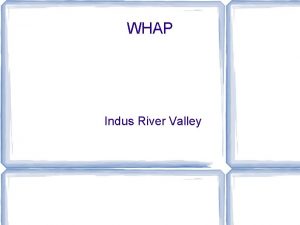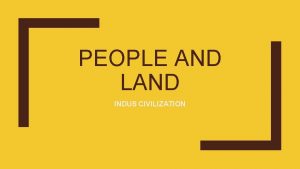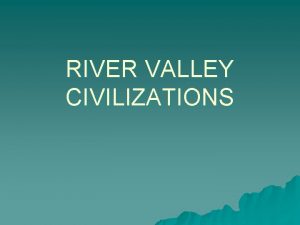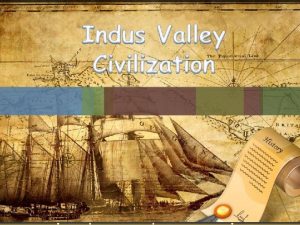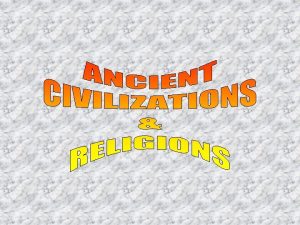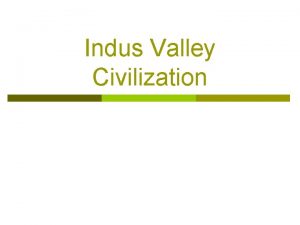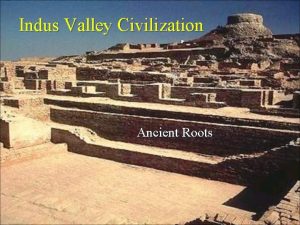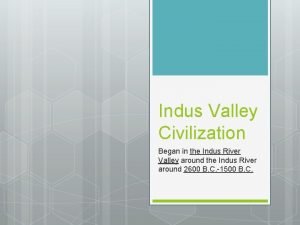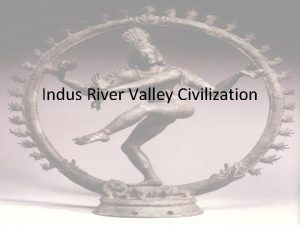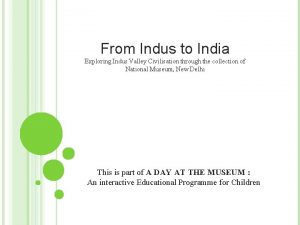WHI 3 INDUS RIVER VALLEY Important Dates India




































- Slides: 36

(WHI. 3) INDUS RIVER VALLEY Important Dates: India Quiz – 10/6 (A 2/ A 3/ BR), 10/7 (B 2/ B 3)

GEOGRAPHY OF ANCIENT INDIA • Classical Indian Civilization began in the Indus River Valley and spread to the Ganges River Valley, then through the Indian subcontinent.

INDUS RIVER VALLEY

India is a subcontinent (underneath a continent) and surrounded on three sides by water — these features make it very hard to invade.

GEOGRAPHIC PROTECTION • The Himalayas and Hindu Kush Mountains plus the Indian Ocean made invasion more difficult.

• Mountain passes in the Hindu Kush provided migration routes into the Indian subcontinent. • Indo-Aryans passed through the Khyber Pass.

KHYBER PASS HINDU KUSH MOUNTAINS

FIRST SETTLEMENTS • Early peoples migrating into India settled around the Indus River Valley. • Two of these early settlements were known as Harrapa and Mohenjo-Daro.

HARAPPA & MOHENJO-DARO • Called the “twin cities”; known for their wellplanned out cities which even included a sewer system.

WHAT HAPPENED TO THE TWIN CITIES? • Mystery until the 1970 s when satellites showed tectonic plate activity suggesting an earthquake wiped them out.

INDO-ARYANS • The Khyber Pass in the Hindu Kush Mountains provided migration routes into the Indian subcontinent for the Indo-Aryans (people from Europe). • These Indo-Aryans conquered others and brought with them a whole new culture and religion (Hinduism).


• The Indo-Aryans Brought: • Hinduism (religion) • Sanskrit (writing) • Caste System (Social Structure)

EMPIRES OF ANCIENT INDIA

THE EMPIRES OF INDIA • Over time new kingdoms developed from the ancestors of early cities. These provided their own accomplishments to the history of India.

THE MAURYAN EMPIRE • Started when Chandragupta Maurya united the Indian subcontinent through war & negotiations.

ASOKA & THE MAURYAN EMPIRE • Asoka helped unify India politically—before many different sections were ruled by other people. • Asoka and the Mauryan Empire are responsible for the spread of Buddhism.

ASOKA AND THE SPREAD OF BUDDHISM

MAURYAN EMPIRE CONTRIBUTIONS • Continued political unification of much of India • Contributions: • Spread Buddhism • Free Hospitals • Veterinary Clinics • Good Roads Boomer Galle is thankful we now have vets to take care of him if he’s sick. Thanks Mauryans!

GUPTA EMPIRE • Over time a new empire known as the Gupta ruled a united India. • The Gupta Empire was a time of peace and prosperity. This peace led to the many achievements of the Gupta Empire. • The Gupta Empire is known as the Golden Age of India for all its achievements.


GUPTA EMPIRE CONTRIBUTIONS • Golden Age of classical Indian Culture • Contributions: • Mathematics (Zero) • Medical Advances (Set Bones) • Astronomy (Earth is round) • New Textiles (cloth) • Literature

Kahoot!!!!!!

RELIGIONS OF ANCIENT INDIA

HINDUISM • Contribution of classical India • Still practiced in India today • Belief in many forms of one God • Called MONISM • Brahmin: is the chief god of Hinduism and is referred to as the “divine essence” of all life

FOUNDER AND HOLY TEXT • Hinduism has no one original founder • The Aryans brought Hinduism to India with them when they migrated there. • Hindu stories and traditions are recorded in their sacred writings of the Vedas & Upanishads and the Bhagavad-Gita.

TEACHINGS OF HINDUISM • Kharma: good or bad force created by a person’s actions.

Reincarnation: is the belief in the rebirth of souls • The soul does not die • The soul is reborn in the body of another human being or animal until it reaches union with Brahma or Moksha

• Moksha: perfect peace with Brahma • When souls reach moksha, the cycle of reincarnation is over.

CASTE SYSTEM • Caste-system: a strict social structure based on occupation (job). Individuals are born into a caste and cannot change it. The only way to change castes is to die and be reincarnated into a different caste.


BUDDHISM • Founded by Siddhartha Gautama (the Buddha) • Founded in present-day Nepal • NO HOLY TEXT • Followed the Four Noble Truths & Eightfold Path • Asoka’s missionaries and their writings spread Buddhism from India to China and other parts of Asia

THE TEACHINGS OF BUDDHA • Reincarnation based on the life a person leads • Good is rewarded, evil is punished • Salvation comes from knowing the Four Noble Truths and following the Eightfold Path

BELIEFS OF BUDDHISM: FOUR NOBLE TRUTHS 1. All human life involves suffering and sorrow 2. The desire for a life of pleasure and material gain causes suffering and sorrow 3. Renouncing desire frees people from suffering and helps their souls attain nirvana 4. The Eightfold Path leads to renunciation, or denial of desire and attainment of nirvana

BELIEFS OF BUDDHISM: THE EIGHTFOLD PATH 1. Right Views • Seeing life as it really is 2. Right Intentions • Living a life of good will, striving toward perfection 3. Right Speech • Avoiding lies and gossip 4. Right Action • Trying to be law-abiding and honest 5. Right Living • Avoiding work that harms others 6. Right Effort • Seeking to prevent evil 7. Right Mindfulness • Constant awareness of one’s self 8. Right Concentration • Directing the mind in mediation

OTHER BUDDHIST TEACHINGS INCLUDE: • It is the goal of the Buddhist to shun desire • Rejected Hindu gods and caste system, but rather taught that priests should live peaceful, ethical, and moral lives of poverty and non-violence • Nirvana is reached after a series of rebirths and union with the universe or perfect peace is achieved
 Indus river valley timeline
Indus river valley timeline Indus valley gender roles
Indus valley gender roles Modern day indus valley
Modern day indus valley Indus era
Indus era Indus and ganges river
Indus and ganges river Indus river valley art
Indus river valley art Indus river valley dbq
Indus river valley dbq Mesopotamia technology
Mesopotamia technology Harappa
Harappa River valley civilizations characteristics
River valley civilizations characteristics Yellow purple brown
Yellow purple brown Whi format
Whi format Whisol
Whisol Harappa location
Harappa location Vedic caste system
Vedic caste system Paano mo masasabing umiiral ang kabihasnan o sibilisasyon
Paano mo masasabing umiiral ang kabihasnan o sibilisasyon Education of indus valley civilization
Education of indus valley civilization Egypt medicine
Egypt medicine Indus river
Indus river Indus valley game
Indus valley game Indus
Indus Indus valley civilization conclusion
Indus valley civilization conclusion Growing up in the indus valley
Growing up in the indus valley Economy of indus valley civilization
Economy of indus valley civilization Conclusion of harappan civilization
Conclusion of harappan civilization Indus valley civilization trade and economy
Indus valley civilization trade and economy Introduction of indus valley civilization
Introduction of indus valley civilization Indus valley seal
Indus valley seal The aryan caste system
The aryan caste system Language b
Language b Indus valley pictures
Indus valley pictures Who discovered indus valley civilization
Who discovered indus valley civilization Growing up in the indus valley
Growing up in the indus valley Introduction about indus valley civilization
Introduction about indus valley civilization Indus valley resources
Indus valley resources Economy of harappan civilization
Economy of harappan civilization River in bc
River in bc
